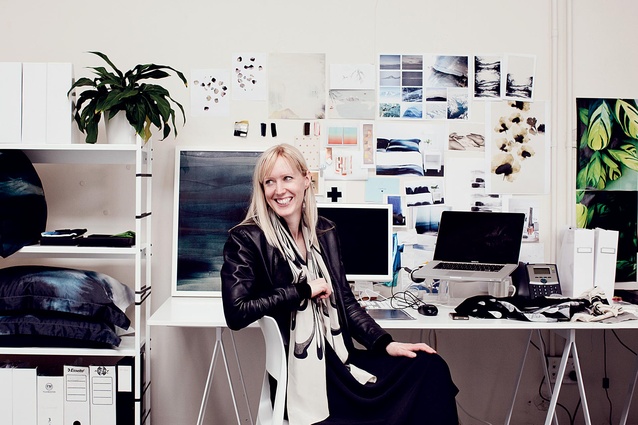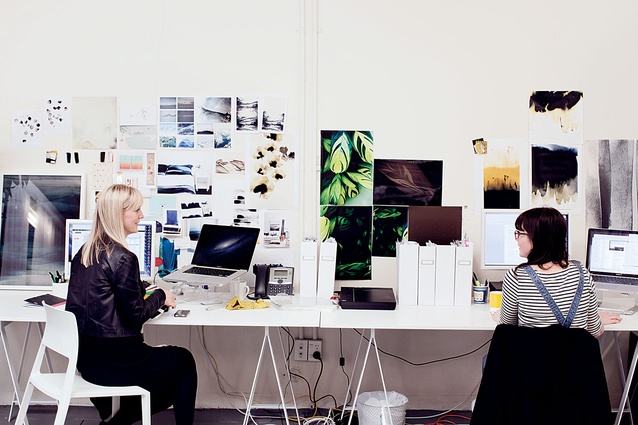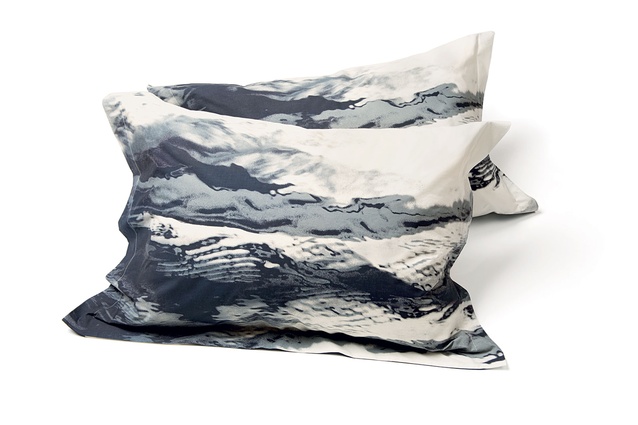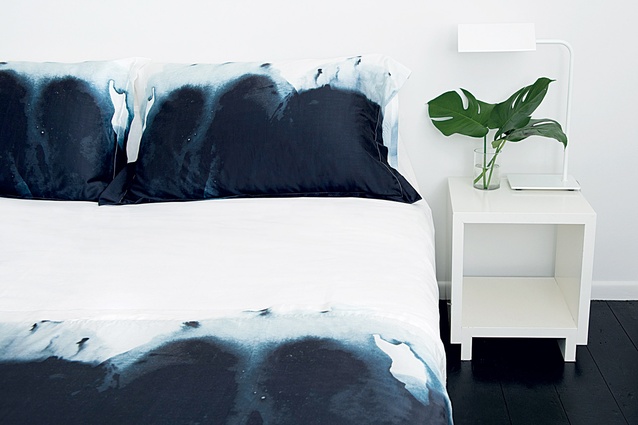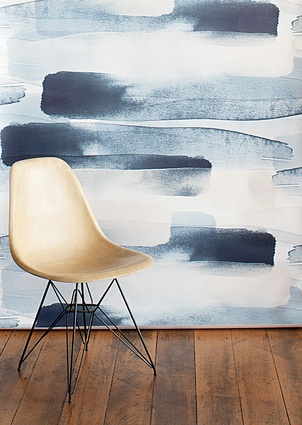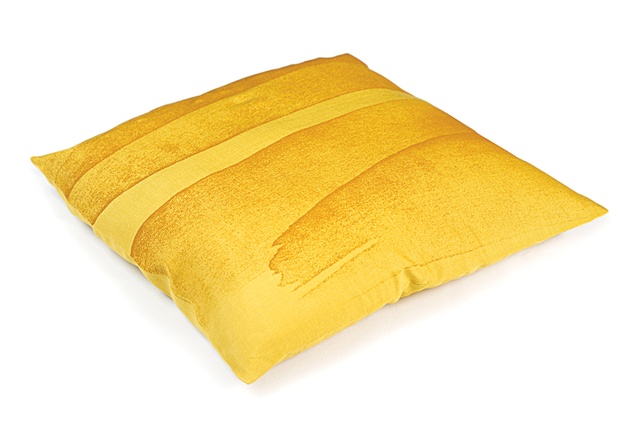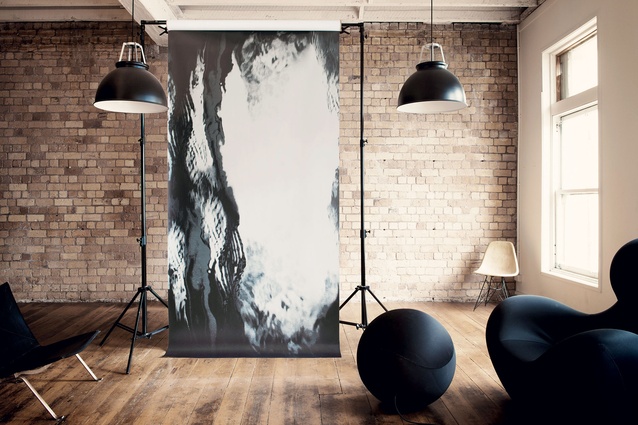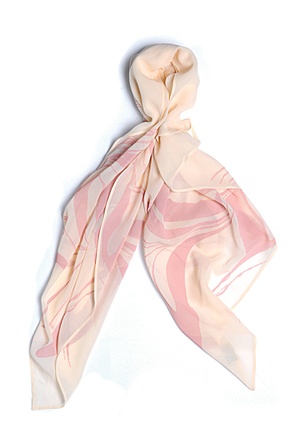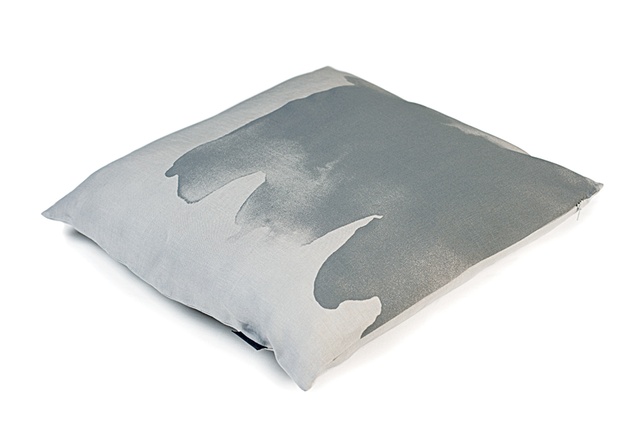Force of nature
Emma Hayes’ career path has wended its way perfectly to her current job. The 35-year-old Auckland resident started out as a graphic designer (where she learnt to think visually and creatively), worked in advertising (where she gained a sense for how to market and present products), segued into the fashion biz (where she honed her skills in making textiles) and, in 2010, started her own eponymous company (where as owner, maker and marketer, she uses all of the above on a daily basis).
Now she and one other staff member spend their working weeks creating hand-printed wallpapers, pillowcases, cushions, prints, scarves and bags that are sold at heavy-hitting design retailers such as Simon James , Backhouse and Corporate Culture . By the end of the year, Emma Hayes will introduce its third collection of moody, sumptuous, hand-drawn prints to the world – growing the export side of the business is near the top of Hayes’ to-do list these days – from a Quay Street studio space in Britomart complete with ocean views and office-mates that work in industrial design and other creative pursuits. Urbis caught up with Hayes there and asked about her burgeoning small business.
Urbis: How did you start in graphic design?
Emma Hayes: I studied at Unitec [Institute of Technology] and graduated in 1999. I worked in advertising here and in the United Kingdom. In New Zealand, I spent quite a bit of time at Inhouse design. They were great people to work with. In the United Kingdom, I was with a design and advertising agency too and did bit of freelancing as well.
U: How did you move into the fashion industry?
EH: In London I took courses at Central Saint Martins and started a T-shirt brand. I’d always just really loved textiles and a hands-on approach and prior to that I had printed things and made my own clothes. When I came back from the UK, I started working with [womenswear label] Cybèle. Initially, I came on board to develop prints part time. Gradually, I came to be involved in various parts of the business: sales and marketing, and collaborating with [owner] Cybèle Wiren. It was an exciting time.
U: Why did you decide to start your own company – and to make homewares your focus?
EH: I wanted to work on some projects that were outside of fashion. I always found it hard to find things I wanted to buy for my home. And there are a lot of fashion designers out there and that was a reason [to concentrate on homewares] as well. I started with an initial collection of textiles, which was picked up by Simon James Concept Store. They were quite supportive about it and are still great at supporting the brand, as are all of our stockists.
U: You are known for your watery, hand-drawn prints.
EH: Yes, that first watery print is still my best-known print. I didn’t intend to do any watery prints but they just evolved that way. I find nature has come through in my designs when I haven’t really intended it to. It does somehow give a sense of New Zealandness to it without being koru or pohutukawa trees but, when I started the brand, I didn’t want to do anything like that; it’s been a subconscious thing. I think my aesthetic has an element of the hand drawn to it and there’s quite often a play or transition between light and dark.
U: How do you come up with your designs?
EH: I do them in watercolour in the first instance. I like making actual marks; that way you get accidents. Or I might start from a photograph I’ve taken. I start with the concept or print ideas for the collection and then specific pieces are generated from there. In terms of the way the textiles look, that’s something I’m really interested in at the moment. I want to push the way textiles are printed: the way things are done. Part of that’s the way I like to work, with layers of colours and textures. It’s not something separate from the fabric; it’s one and the same thing. What’s important to me is how the print relates to the form of the item, and I use fabrics and print finishes to highlight that as well. So my River print feels like it is dripping off the bed.
U: How and where are the products then produced?
EH: I work with some local producers but I can’t print this fabric in New Zealand. It would be good if I could but it’s milled offshore. We work with local manufacturers to do our samples and to make our final products; if we can, we do it here. The products are reasonably expensive, reflective of the material they’re made of. The bed sets are our best sellers. All of our more luxury pieces have been selling really well, which is great. We’ve got some more bed linens coming up – and wallpaper – before the end of the year. Again the prints are quite watery, moody.
U: You also make accessories – scarves and furoshiki (fabric carry bags). Is it easy to think about both homewares and accessories?
EH: If I have a print in progress, I’m usually thinking how it will specifically work across a piece or pieces. With the River print, I wanted to give the idea of a flowing restfulness with brush strokes. A scarf print, however, may be more about how it may swirl or wrap around the body. In my head I want to keep the accessories and homewares separate because I don’t want to wear what people also cover their couch with. The accessories are about gradually growing our offering. It’s about diversifying our price point too.
U: How has the company grown since that first small collection?
EH: There’s been a new collection every year so far but, going forward, it will be every six months. I think in New Zealand you can start a business more easily [than you can in other countries] but you also think about export a lot quicker because the market is small. Currently, we sell into some stores in Hong Kong and China. With the next range, getting into other markets will be a focus. I’d like the company to be a lot bigger than it is now; we’ve got a lot of growing to do in terms of what we offer.
U: How do you juggle the business side and the creative side of being in business?
EH: Time is a big challenge; more is spent on the business side of things. It’d be lovely to spend a lot of time designing but it’s not possible. You need to be aware of what time you’re spending with what, on managing your manufacturing relationships. We do work for private clients too; bespoke prints for fashion designers. We’re just working on a bespoke paper for a restaurant, which is great, because we can consider the space it’s going into. We’ve just done some cushions for Peter Gordon’s new restaurant, The Sugar Club. We work on graphic projects as well.
U: You share an office space with designer Jamie McLellan and Milk, a creative consultancy. Does it enhance your creativity to work in a space like that?
EH: I find it good having somewhere to go to to work. And I enjoy it here with all of the disciplines going on. It’s good to have people around to talk with. We work quite independently but Jamie and Andy will sometimes pipe up with things and we pick up on what the others are doing. The boys are the hard, industrial side and we’re the girly side with our textiles.
U: What about your own living space? Is it covered in Emma Hayes’ designs?
EH: I’ve just moved to a little bungalow, which is currently green and gold and needs a little work. We didn’t set out specifically to buy a bungalow but this particular house just ticked a few boxes. I am excited about this project and how it may inform further pieces to be developed for the collections. I am also looking forward to the challenge of retaining its heritage whilst adding some of my own aesthetic. But my boyfriend says I’m like a builder – nothing gets done interiors-wise!

